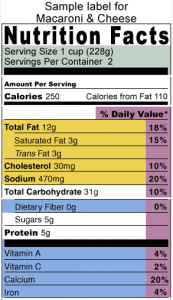Nutritional Value of Lipids
Good Fats vs Bad Fats (from HealthiNation)
Original Source: https://www.youtube.com/watch?v=6esFOqj_IaY
Nutritional Example
Examining the nutritional label below, we can see that this brand of Macroni and Cheese contains a total of 12 grams of fat per serving. 3 out of the 12 grams of fat are ‘Saturated’ while 3 grams are considered ‘Trans’. Trans fats are ‘artificially straightened’ fat molecules created through a process of hydrogenation. Since trans fats cannot be metabolized as efficiently as other fat molecules and have been linked to elevated cholesterol levels.

We can also calculcate that 2 serving(s) of Macaroni and Cheese would contain:
- 500 Calories
- 220 Calories from Fat
- 24 grams Total Fat
- 6 grams of Saturated Fat
- 6 grams of Trans Fat
Summary
Fats and oils are forms of lipids. Lipids include triglycerides, phospholipids, and sterols. Fats have several important roles in the body. They provide energy and essential fatty acids for hormone production and nervous system health, transport fat-soluble vitamins, regulate cell function, maintain cell membrane integrity, protect vital organs, and contribute to flavor and satiety of meals.
Triglycerides are the most common dietary fat and are composed of glycerol and three fatty acids. The fatty acids can be classified on the basis of chain length, level of saturation, and shape. Saturated fatty acids have no double bonds and are solid at room temperature. These are found predominately in animal-based foods. Unsaturated fatty acids contain one or more double bonds and are liquid at room temperature. These are found predominately in plant-based foods. A cis fatty acid has hydrogen atoms on the same side of the double bond, while a trans fatty acid has hydrogen located on opposite sides of the double bond. Trans fats, made from unsaturated oils through a process called hydrogenation, are solid at room temperature. These are used by the food industry to enhance flavor, texture, and shelf life.
The types of fats that we ingest can either enhance our health or harm it. In general, unsaturated fats are considered the “healthier fat”. Diets high in saturated and trans fat increase the risk of cardiovascular disease and may be linked to certain forms of cancer and neurological diseases. No more than 6% of your total intake of fat should be saturated fat. You should avoid trans fats altogether.